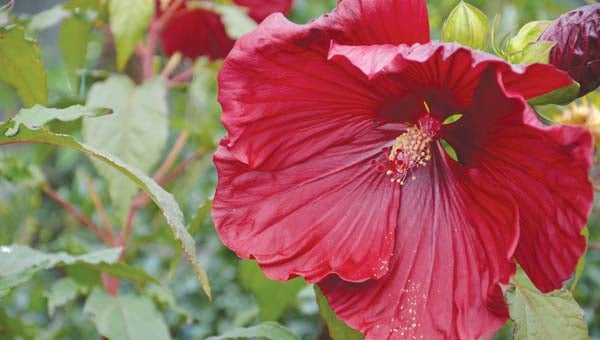Fall gardening
Published 9:10 am Monday, September 7, 2015

Star Photo/Rebekah Price
Hybiscus. Pruning Hibiscus, Hydrangea. potted shrubs and succulents from mid-September to early October is important to get more flowers density and bushiness.
April showers will bring May flowers, but September pruning will leave your neighbors swooning over your flourishing burgundy hibiscus, bushy hydrangea and trees laden with fruit the following year.
September through October should not be the season of neglect in the yard and garden. It is prime planting and pruning time.
Dean Fulton, co-owner of Creekside Nursery, said he has people come in frequently at this time of year wondering if they can still plant, and the answer is yes.
“Fall is actually a little bit better time to plant than in spring,” said Fulton. He explained that the hot, dry climate of summer is harsh on a number of spring plants, leading to damaged leaves and underdeveloped root systems.
“Right now we’re just getting into the time to do the planting, from mid-September to the end of October,” Fulton said.
Suggested vegetable starts to plant in full sun now are onions, radishes, broccoli and greens: cabbage, kale, chard, Brussels sprouts and turnips.
Lettuce can be planted from seed at this time and used as a ground cover. Fulton suggests planting the seed thoroughly in an area, letting it grow, picking from it for food and then tilling what is left back into the soil in spring. He said the lettuce absorbs nutrients that will decompose at the soil’s surface, making it a more nutrient-rich bed for the spring.
Co-owner Kim Fulton suggested using lettuce and chard in pots with other ornamentals to add texture, color and utility.
Another way to do this is by incorporating ornamental cabbages of purple or green and ornamental peppers that can grow orange, red and purple on one plant.
Add color to the garden or potted arrangements with mums and pansies that bloom throughout the fall. If planted in the ground, mums will grow year-round and bloom each September and October. During the winter, the branches will die, but the plant is alive below ground, so leaving the stems as winter protection and pruning in the spring will benefit the next year’s growth.
Spinach and lettuce develop red and purple coloration in cool temperatures and mild frosts, as well as getting sweeter and losing the bitterness sometimes present in a summer harvest.
October is wetter and allows roots to establish themselves, even until mid-December for perennials. During this time, the difference above ground may not be noticeable, but by spring, if bulbs, trees, shrubs and other perennials are planted in the fall, they will be more well-developed, vibrant and sturdy than if they were planted in spring.
Many perennials must be pruned in the fall in order to bloom the next year, like hydrangeas. Others simply flower more and grow bushier when pruned, like with hibiscus and oleander, which are best pruned after the flowers are dormant, in the last two weeks of September.
Though many people trim roses in September in East Tennessee, the continuing warm weather will likely stimulate growth, and therefore pruning should be delayed until the last week of November until mid-December, according to the Nashville Rose Society. At this time, prune back two to three feet, and do not fertilize till spring. In September, the process of dead-heading, the removal of spent buds, can be discontinued as well to signal the end of the productive season to the rose plant.
Preparing for the dormancy of perennials can mean a grand difference in the garden’s appearance and production in the spring. With proper pruning and planting, winter will be a time of eager anticipation.




